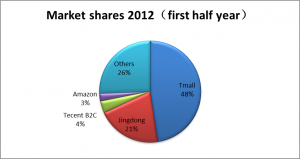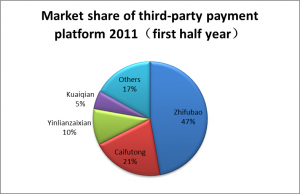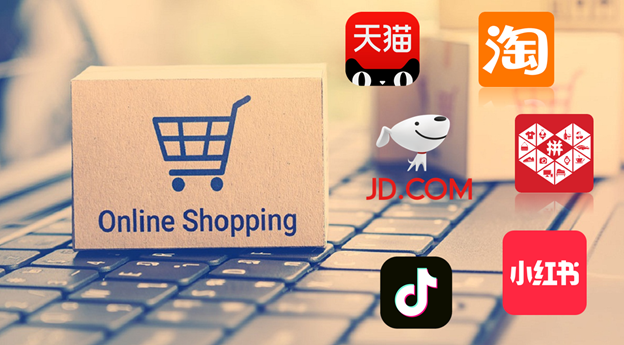Tmall VS. Shangpin
Tmall
Tmall, spun off from Taobao into a separate business in 2012, is the largest B2C e-commerce platform in China. The site stocks over 70,000 Chinese and international brands and sells almost everything from socks to laptops. According to the Alibaba Group, Tmall’s gross merchandise value exceeded 100 billion RMB in 2011 and is expected to reach 200 billion RMB by the end of 2012. By June 2012, Tmall still dominated the B2C e-commerce market in China, with a market share of 47.6%, while the market share of the second best, Jingdong, was just 20.5%. In the short-run, Tmall and its main competitor, Jingdong, are expected to occupy the leading position firmly in terms of market shares.
Business model
A business model is a method and a set of assumptions that explains how a business creates value and earns profits in a competitive environment. In particular, Tmall’s business model is a hybrid model of two traditional business models: commission-based and advertising-based. More precisely, Tmall charges a membership fee to merchants using its platform. It also sells advertising to business, usually the merchants on the platform. Recently, the daily transaction volume of Tmall is expected to exceed RMB 1 billion and daily pageviews are about 280 million, both of which are the advantages of adopting advertising-based business model. In addition, the buyers pay to Zhifubao when the transaction is done, while this amount of money would typically be transferred to the sellers after the buyers confirm the reception of the items, which is usually 6-7 days later. By this way, Zhifubao, the third-party payment platform created by Alibaba Group, provide extra cash flow for Tmall. Theoretically, this extra liquidity can be invested or, at least, provide a steady channel of finance.
Why Tmall succeeds?
Price efficiency
Not surprisingly, the products in Tmall are much cheaper than those in traditional malls. The competitive advantage of price stems from two sources: one is the inherent cost efficiency of B2C e-commerce; the other is competition among merchants on the platform, since there are 0.93 million merchants on the platform.
Trust and Confidence
Just as mentioned above, Zhifubao is created to ensure the benefits of both sides of trades and significantly reduces the transaction cost, which makes the trade in Tmall a more joyful one. Now, it is the most renowned third-party payment platform with a dominating position in the third-party payment market.
Additionally, Tmall guarantees up to five times the price of a product in compensation if customers find that they purchased fake items on the platform. By doing so, it tries to convey the information that the products in Tmall are not only inexpensive but also with high quality.
Besides, the rating system (or customer feedback) system also improves the value proposition of the site. Buyers often trust what other buyers say more than a company’s promises. It facilitates the customers to identify the good shops, therefore encourages them to purchase on this platform.
Rich variety
The site stocks over 70,000 Chinese and international brands and sells almost everything from socks to laptops. It is very convenient for customers to find what they really need on the platform.
Tmall in China magazine
Shangpin
Shangpin is one of the most popular B2C platforms, which was focus on luxuries. It announced the platform included most of the top luxury brands from handbags to jewelry. The platform also offered very aggressive price, which could be as low as 80% discount, while it guaranteed that there were no fake items on the platform. However, it was announced on December 28th 2011 that Shangbin would shut down on December 31st and the domain name, L.163.com, would stop operating from January 1st 2012. In other words, Shangpin announced failure in less than one year.
Business model
Unfortunately, there is no clear business model of Shangpin, which might be one of the reasons why it failed in just one year. Until it shut down, it was still on the stage of ‘burying money’. The proceeding business model of other luxury online merchant is just ‘buy low and sell high’, which is relatively hard to earn an impressive profit.
Why Shangpin fails?
Price efficiency
During the inherent characteristics of luxury industry, it is almost impossible and infeasible to get luxury products that are in fashion at an aggressive price.
Nevertheless, the services and the respectable feeling when shopping in offline shops are also essential in luxury consuming. Therefore, unless there is big price concession, customers are more willing to shop in traditional luxury shops. This mismatch between businesses and customers was the main problem perplexing the platform.
Trust & confidence
Irretrievably, China’s online market is notorious for selling fakes and gray-market products. Customers generally hesitate to purchase luxuries online, unless the platform is prestigious. However, the consumer confidence is, to some degree, easy to establish when the merchandise is relatively inexpensive. When it comes to luxury products, it is supposed to take more time to build the T&C. Before the reputation is established, the site has to face the short-time financial gap frequently, if it fails to access a steady financial source.
Rich variety
Worried about the fakes and gray products, some brands refused to cooperate with the platform. Therefore, both the variety of the products and amount of the inventories on the platform were quite limited, which in turn lead to unpleasantly shopping experience. It was extremely harmful for Shangpin to build its own reputation.
Shangpin in the Financial Time
The internet and digital technologies have created new opportunities for B2C e-commerce. As the Internet continues to grow and influence our lives even more, there is no telling how far e-commerce will develop. This report analyzed the enablers of surviving in the competitive B2C e-commerce environment with the example of Tmall and Shangpin. The firms want to benefit from these new technology revolutions and developments need to contemplate how to lower the price, how to establish Trust & Confidence and how to enrich their products. Additionally, Identifying the practices and appropriate business models is also central to using the Internet to create wealth.






